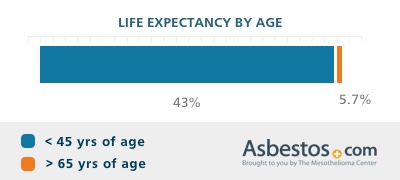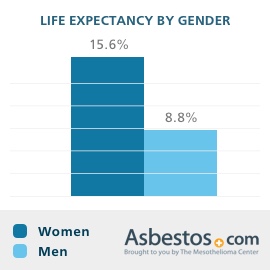How Is Life Expectancy Affected by Cell Type? The type of cells that make up mesothelioma tumors, called histology, has the greatest impact on how long someone may live with the cancer. Mesothelioma tumors are made up of epithelial or sarcomatoid cells, or a mix of the two, which is called biphasic. People with epithelial tumors tend to live longer than people with sarcomatoid tumors — upwards of seven months longer.A 1996 study published in the esteemed journal Chest evaluated the impact cell type has on life expectancy. Participants with epithelial cells lived nearly seven months longer than those with sarcomatoid cells. There was no significant survival difference among biphasic patients with high or low ratios of epithelial to sarcomatoid cells.The longest survival was among patients with a subtype of epithelial cells called tubulopapillary. These participants lived 6.5 months longer than those with other epithelial subtypes.

Without electing any treatment, stage I pleural mesothelioma patients can expect to live about two years. Stage I patients who undergo an extrapleural pneumonectomy surgery have a median life expectancy of 40 months, just over three years. Nearly 30 percent of stage II pleural patients live that long following surgery.

How Is Life Expectancy Affected by Your Overall Health? Asbestos exposure can cause cancer to develop in anyone, regardless of their overall health. Although mesothelioma strikes healthy and unhealthy people alike, healthy people tend to live longer with the disease.Certain factors can shorten life expectancy, including a sedentary lifestyle, poor diet, mental health conditions and weak social connections. Exposure to toxins like cigarette smoke, radon and asbestos can also affect a person's life expectancy.Oncologists determine a person’s overall health using a scoring system called performance status. It basically assesses the ability to perform physical activities and basic self-care. Doctors use various scoring systems to grade performance status.The Eastern Cooperative Oncology Group (ECOG) developed one popular grading system called the ECOG Scale of Performance Status. The scale ranges from zero to five, with zero representing a fully active person. Ascending numbers represent increasing disability.People with low ECOG performance scores, indicating better overall health, tend to live longer with mesothelioma than people with high scores. A comprehensive study conducted in the late 1980s and '90s reported overall survival of 11 months for people with a performance score of zero, 7.6 months for a score of 1 and 3.3 months for a score of 3.Taking good care of your health by eating well and staying active when possible can help people recover quicker from cancer treatments like surgery and chemotherapy.
As the stages of disease become more advanced, not only does the mesothelioma prognosis worsen, but patients face more limited treatment options. Because mesothelioma itself is so aggressive, patients who are able to undergo equally aggressive treatment have a better chance of longer survival. Most patients do, however, have a multimodal treatment, meaning they receive multiple types of therapy in combination whether to attempt to cure the disease or for palliative purposes.
Tumor Removal: Surgery is usually not an option as most cases of mesothelioma are discovered after the disease has advanced to its later stages. However, if the disease is caught early and the tumor can be surgically removed, survival rate is usually prolonged.
Background. Mesothelioma is a rare cancer with a historically dire prognosis. We sought to calculate life expectancies for patients with pleural or peritoneal mesothelioma, both at time of diagnosis and several years later, and to examine whether survival has improved in recent years. Methods. Data on 10,258 pleural and 1,229 peritoneal patients from the SEER US national cancer database, 1973–2011, were analyzed using the Cox proportional hazards regression model. Results. The major factors related to survival were age, sex, stage, grade, histology, and treatment. Survival improved only modestly over the study period: 0.5% per year for pleural and 2% for peritoneal. Conclusions. Life expectancies were markedly reduced from normal, even amongst 5-year survivors with the most favorable characteristics and treatment options.
At stage 2 the cancer has begun to spread to surrounding areas and the symptoms have become worse. The patient may become short of breath, have a chronic cough and/or have chest pain. Curative treatment is still possible at this stage. The treatment plan is multimodal and includes surgery, chemotherapy and radiation. The life expectancy with diagnosis and treatment at stage 2 is 2 years.
Previous research has identified factors related to survival and reported on various survival probabilities, including the median survival time, but has not provided life expectancies (the average survival times). As explained by Stephen Jay Gould, who himself had abdominal mesothelioma, the median does not capture the effect of outliers, nor does it provide the prognosis for someone who has already survived the first (high-risk) year after diagnosis .
There is a chance that your best opportunity for extending your life expectancy could come from experimental treatment in a clinical trial. Mesothelioma researchers constantly test new medications and treatment approaches, and clinical trials allow patients to take advantage of new treatments that may extend mesothelioma survival. Unfortunately, new treatments may also come with a higher element of risk.
The term “life expectancy” refers to the average period that a patient can expect to live after being diagnosed with mesothelioma. For example, if the reported median life expectancy is 12 months, half of the patients will live beyond 12 months and the other half will not.
For mesothelioma cancer patients, the median life expectancy – that is, the high point on a bell curve – is 4 to 18 months. However, an individual patient’s case has much more to consider. Some patients may end up surviving mesothelioma for a longer period of time, while others may have a shorter lifespan following diagnosis.
Stage 4 is the last and also considered the most severe stage of mesothelioma. A patient’s expected life span at this stage is 13 months or less because the lymph nodes are extensively involved, the cancer is malignant, the cancer cells have spread throughout the chest cavity and has most likely metastasized into the abdomen, heart, or other organs.
As with most cancers, mesothelioma has historically been staged as localized, regional, or distant metastasis (LRD staging system). More recently a specialized TNM system has been used , with associated summary staging (I through IV) based on the individual values of T, N, and M. Of the cases in the US National SEER database used here for which staging information exists (roughly 80% of cases), LRD was the primary staging system through 2003 for pleural and 2009 for peritoneal, after which times the TNM system became almost exclusively used. Two clinical systems specifically designed for staging mesothelioma, the Butchart and Brigham systems, are not represented in the SEER database and were therefore not used in our analysis. Because our interests here were on life expectancy (i.e., long-term survival) and changes in survival over time, we opted to use the staging system (LRD) covering the longest period of the available data even though it is less useful clinically, especially in peritoneal cases.